With the generous support of the Costume Society’s Daphne Bullard Grant, we were excited to invite Joanna Whalley, a metals and jewellery conservator, to the Museum to carry out conservation work on the pair of shoe buckles once owned by Marc Brunel in our collection. Donated by Brunel’s descendants in 2007, little was known about the buckles until research work began in 2023. This examined their intriguing link to the French Revolution, considered how they tell stories of repair and reuse, and emphasised the importance of dress to the Brunel family’s public images.
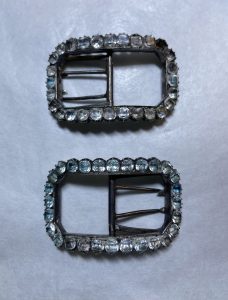
The front of the buckles, before conservation treatment
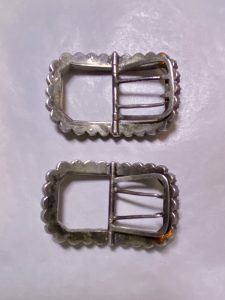
The back of the buckles, before conservation treatment


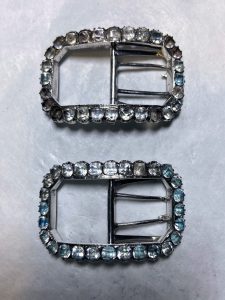
The front of the buckles, following conservation treatment
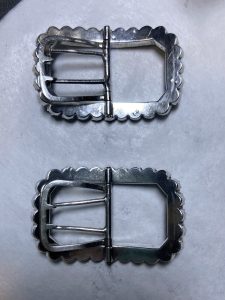
The back of the buckles, following conservation treatment

![]() Carrying out conservation work on the buckles ensures they are stable and ready for permanent display in the new permanent gallery due to open in 2025 as part of the Brunel Museum Reinvented Project. It has also allowed us to restore some of the buckles’ shine and sparkle, as well as learn more about the materials used to produce them.
Carrying out conservation work on the buckles ensures they are stable and ready for permanent display in the new permanent gallery due to open in 2025 as part of the Brunel Museum Reinvented Project. It has also allowed us to restore some of the buckles’ shine and sparkle, as well as learn more about the materials used to produce them.
Joanna’s treatment concentrated largely on examining and cleaning the buckles. She confirmed our assumptions that the buckles’ stones are paste, a common material in eighteenth-century jewellery which imitates diamonds. As is typical for objects of this kind and period, the paste gemstones had black dots painted on the reverse and were then set on silvered foils, both techniques used to further develop the stones’ sparkle. These silvered foils have since tarnished significantly. The buckles themselves are made of a mixture of silver, and silver-plated steel. The use of plated steel made the buckles both cheaper than solid silver, and hard-wearing for use on shoes.
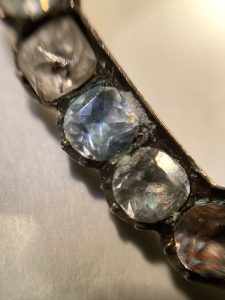
Close-up of the stones, showing soap deposits around the stones and the blue colour caused by a chemical reaction with copper or nickel in the foils
Pre-treatment examination had found significant deposits of a white residue around the stones. This was thought to be old silver polish. In some areas, this residue has seeped behind the stones and caused a chemical reaction on the foils which now causes some of the clear stones appear to glow blue, indicating that the foils beneath contain copper or nickel.
Examination under a microscope in fact indicated the residue was likely soap – suggesting at some point someone gave up on polish and used soap to get the grime off instead! This was dry brushed and then removed with a bamboo pick. The surfaces were then cleaned with denatured ethanol before tarnish was removed using silicon rubber embedded with a precipitate of calcium carbonate.
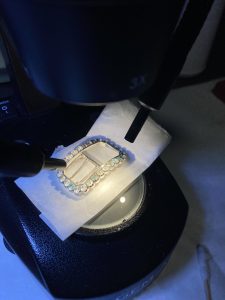
Examination of the buckles under a microscope
Close examination of the buckles has revealed a number of interesting aspects. It was apparent to the naked eye that stones in the buckles had been replaced. Joanna’s conservation treatment shown that at least 12 out 55 surviving stones have been replaced. This suggests the buckles underwent a number of repairs during their use. They were probably very special objects especially worth fixing so they could be worn again.
One stone has been lost entirely; it was decided not to replace this stone, but to leave it as evidence of the buckles’ material history. Other damage to the buckles also tells stories of their repeated use, including the complete loss of silver plate on one of the twines which would have been pushed through the shoe to fasten it.
We are excited now to redisplay these buckles, and to show visitors the sparkling accessories the Brunels owned: quite distinct from the usual image of austere engineers often working in grimy conditions! You can find the buckles on display upstairs in the gallery when you next visit. In time, they will form part of a new display of the family’s decorative personal affects, including Mary Horsley’s painted and gilt fan, and Isambard Kingdom Brunel’s wax seal.
